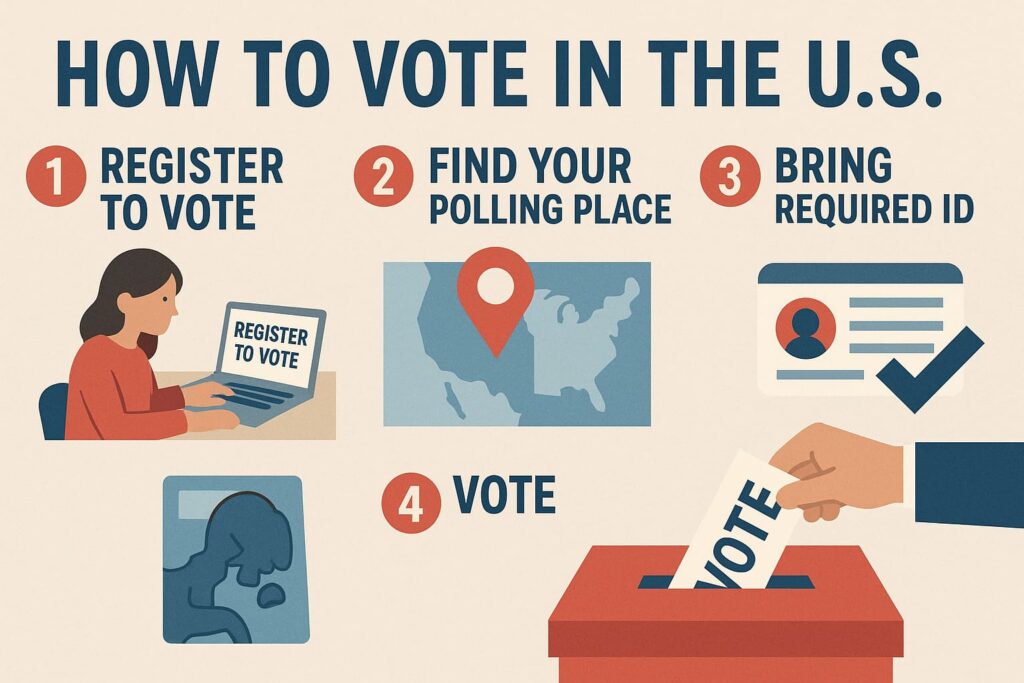Voting is a fundamental right and responsibility for citizens in the United States. Whether you’re a first-time voter or need a refresher, this guide will walk you through the process of voting in the US, ensuring you’re prepared to make your voice heard. From registering to casting your ballot, we’ve got you covered with clear, actionable steps.
Why Voting Matters
Voting allows you to influence decisions that impact your community, state, and nation. From electing local officials to choosing the President, your vote shapes policies on education, healthcare, the economy, and more. Participating in elections empowers you to contribute to the democratic process and advocate for the issues you care about.
Step 1: Check Your Voter Eligibility
Before you can vote, you must meet certain eligibility requirements. In the United States, you can vote if you:
- Are a U.S. citizen.
- Are at least 18 years old on or before Election Day.
- Meet your state’s residency requirements.
- Are not currently incarcerated for a felony (rules vary by state).
- Have not been declared mentally incompetent by a court (varies by state).
Each state has specific rules, so verify your eligibility through your state’s election website or the official Vote.gov portal.
Step 2: Register to Vote
To vote, you must be registered. Here’s how to get started:
When to Register
Most states require you to register at least 15–30 days before an election. Some states allow same-day registration, but it’s best to register early to avoid complications.
How to Register
- Online: Visit Vote.gov to register online in most states. You’ll need a valid ID, such as a driver’s license or state ID.
- In Person: Go to your local election office, Department of Motor Vehicles (DMV), or other designated locations.
- By Mail: Download a voter registration form from your state’s election website, fill it out, and mail it to the address provided.
Required Information
When registering, you’ll typically need to provide:
- Your full name
- Date of birth
- Home address
- A form of identification (e.g., driver’s license number or Social Security number)
Verifying Your Registration
After registering, confirm your status on your state’s election website or through Vote.org. This ensures your information is correct and you’re ready to vote.
Step 3: Understand Your Voting Options
In the US, you can vote in several ways, depending on your state’s rules and your preferences. Here are the main options:
1. In-Person Voting on Election Day
- When: Most elections are held on the first Tuesday after the first Monday in November, though some local elections may occur at other times.
- Where: You’ll vote at a designated polling place, typically a school, community center, or library. Find your polling location on your state’s election website or by contacting your local election office.
- What to Bring: Bring a valid photo ID (requirements vary by state). Some states don’t require ID but may ask for your name and address to verify your registration.
2. Early Voting
Many states offer early voting, allowing you to cast your ballot in person before Election Day. Check your state’s early voting schedule and locations for details.
3. Mail-In or Absentee Voting
- Who Can Use It: Most states allow any voter to request a mail-in ballot, while others require a reason (e.g., being out of state or having a disability).
- How to Request: Request a mail-in ballot through your state’s election website or local election office. Deadlines vary, so plan ahead.
- How It Works: You’ll receive a ballot by mail, complete it, and return it by the deadline (usually by Election Day or a few days before). Follow instructions carefully to ensure your vote is counted.
4. Voting with a Disability
Polling places must be accessible, and accommodations like large-print ballots, audio ballots, or assistance are available. Contact your local election office to learn about options for voters with disabilities.
Step 4: Research Candidates and Issues
To make an informed vote, take time to learn about the candidates and ballot measures. Here’s how:
- Review Voter Guides: Many states provide voter guides with information on candidates and propositions. You can also find nonpartisan guides from organizations like the League of Women Voters or Ballotpedia.
- Attend Candidate Forums: Watch debates or attend town halls to hear directly from candidates.
- Check Reliable Sources: Use trusted news outlets and fact-checking websites like FactCheck.org to verify claims.
- Understand Ballot Measures: Read summaries of proposed laws or amendments to know what you’re voting on.
Step 5: Cast Your Vote
On Election Day
- Arrive Prepared: Bring your ID and know your polling place and hours (typically 7 AM to 8 PM, but this varies).
- Follow Instructions: At the polling place, check in with election officials, receive your ballot, and follow instructions to mark your choices.
- Ask for Help: If you’re unsure how to use voting equipment, ask a poll worker for assistance.
For Mail-In Voting
- Follow all instructions included with your ballot.
- Sign the envelope if required (some states verify signatures).
- Mail your ballot early to meet deadlines, or use a designated drop box if available.
Step 6: Track Your Vote (If Applicable)
If you vote by mail, many states allow you to track your ballot’s status online. Visit your state’s election website to confirm your ballot was received and counted.
Step 7: Stay Engaged After Voting
Voting is just the beginning. Stay involved by:
- Contacting elected officials to share your views.
- Joining community organizations to advocate for causes you care about.
- Volunteering as a poll worker for future elections.
Common Questions About Voting in the US
Can I vote if I’m a college student living away from home?
Yes! You can register to vote at your college address or your permanent home address. Choose one location to avoid voting twice, which is illegal.
What if I miss the registration deadline?
Some states allow same-day registration on Election Day or during early voting. Check your state’s rules.
Can non-citizens vote?
No, only U.S. citizens can vote in federal, state, and most local elections. Some localities allow non-citizens to vote in specific elections, like school board races.
What if I make a mistake on my ballot?
For in-person voting, ask for a new ballot if you make a mistake. For mail-in ballots, contact your election office for guidance.
Key Tips for a Smooth Voting Experience
- Register early to avoid last-minute issues.
- Double-check your polling place and ID requirements.
- Plan to vote early or by mail if your schedule is busy on Election Day.
- Stay informed about candidates and issues to make confident choices.
Conclusion
Voting in the US is a powerful way to shape the future. By following these steps—checking eligibility, registering, researching, and casting your ballot—you can participate confidently in the democratic process. Every vote counts, so make sure yours is heard!
For more information, visit Vote.gov or your state’s election website. Happy voting!
Also read:



